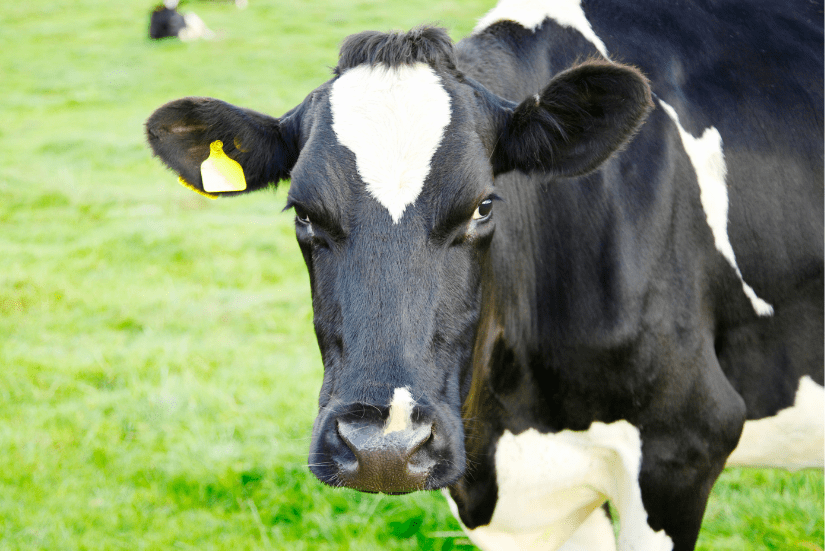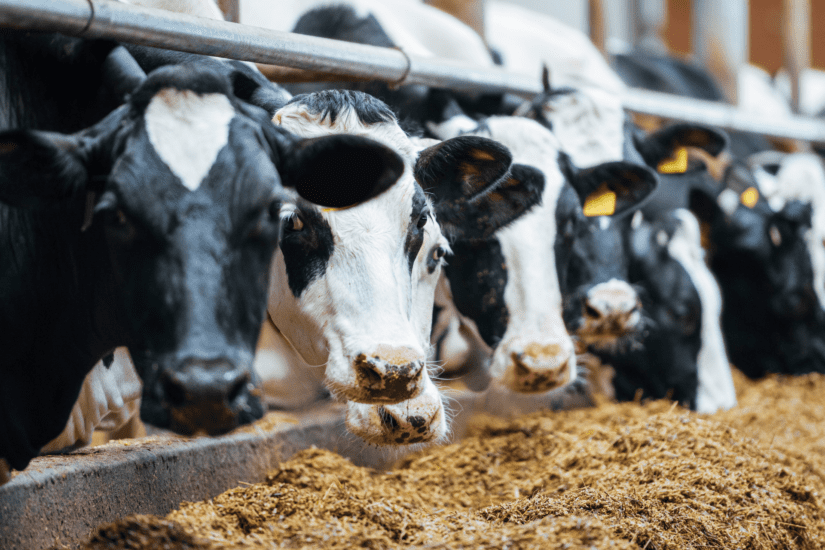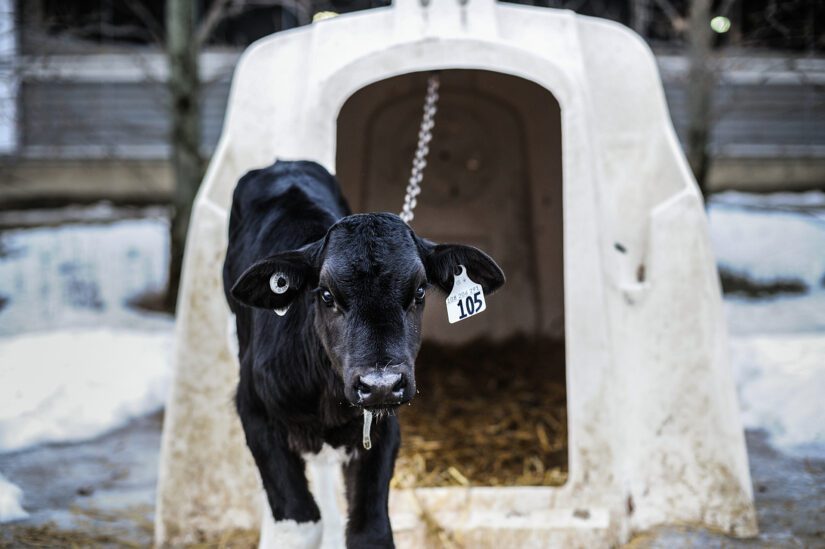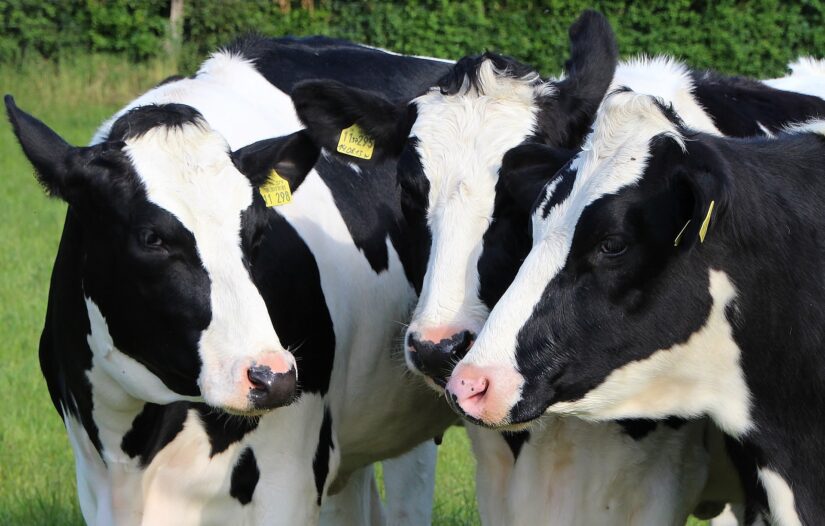In Canada, there are approximately 1.4 million dairy cattle on over 9,000 farms across the country. Dairy farming is the top agricultural industry in B.C. – there are over 400 farms across the province with an average of 150 cows per farm.

Life of a dairy cow
For a cow to produce milk, she must give birth to a calf. A female that has not yet given birth is called a heifer. Heifers are bred for the first time around 12-15 months of age. Breeding is typically done through artificial insemination. After a nine-month pregnancy, the heifer will give birth to her first calf, after which they are referred to as cows (adult females).
After giving birth to a calf, the cow begins her lactation (producing milk). The cow and calf are usually separated a few hours after birth – the calf will be fed by caretakers while the cow enters the milking herd. About three months after giving birth, the cow is re-bred. Cows will produce milk for about 10 months. When her milk production drops, farmers will adjust milking and/or feeding to stop milk production. This creates a two-month “dry” period to prepare for the birth of her next calf. Once the next calf is born, a new lactation starts, and this cycle repeats.
Cows are usually milked two or three times each day, each producing an average of 30 litres of milk daily.
Most cows will stay in the milking herd, repeating the cycle of breeding and lactation, for about five years. After this point, their milk production decreases, and the cows are typically sold to be slaughtered for beef. This is much shorter than their natural lifespan of 15 to 20 years.
Female calves born on dairy farms are usually kept and raised as “replacement heifers” – to replace the older cows in the herd. Male calves are typically raised for veal or beef, while a few may be kept as breeding animals.
Get the full story about how dairy cattle are commonly raised in Canada (PDF).

Welfare issues for dairy cows
Cow-calf separation
The standard practice in the dairy industry is to remove the calf from their mother within the first few hours of life, which is stressful for both the calf and cow. The calf is then usually fed milk replacer, and the cow is milked for human consumption. Some dairy farms are experimenting with leaving the cow and calf together for longer and finding it has health and welfare benefits. Other farms use nurse cows, where one ‘foster’ cow cares for multiple calves.
Calf housing
Most dairy farmers remove calves from their mothers after birth and house them individually to protect their health until they build a stronger immune system. However, calves are highly motivated to socialize with one another, and individual housing does not permit this.
The dairy industry has recognized the benefits of social housing for calves with updates to the Code of Practice for the Care and Handling of Dairy Cattle (2023). For indoor calf housing, tethering is not permitted, and all calves over four weeks of age must be housed in pairs or groups by 2031. While this is an improvement, calves are still allowed to be housed individually outdoors in plastic structures called hutches, where they are tethered in place, limiting their freedom of movement and ability to socialize. The BC SPCA advocates that calves removed from their mothers be housed in pairs or small groups after birth.

Tie stalls
Tie stalls are a form of restrictive indoor housing where cows are tethered and contained within their individual stall. Cows housed in tie stalls get little opportunity to exercise, socialize, groom, graze or perform many other important natural behaviours. Tie stalls are common in Canada – 72.9% of dairy barns in Canada use this housing system. B.C. is ahead of Canada, with only 4.3% of dairy barns using tie stalls. To improve the welfare of dairy cows, the industry committed by 2027 that cows must not be tethered continuously – they must be provided sufficient regular opportunities for freedom of movement. While this is a significant step forward for the dairy industry, the frequency is unclear. The BC SPCA advocates that tie stalls should be prohibited to ensure cows can freely exercise and socialize with one another.

Lameness
Lameness is a painful condition for dairy cows, where the dairy cow has soreness in her leg or foot, causing her to walk unevenly. It results in decreased mobility and lower feed intake and can lead to early slaughter or euthanasia. The environment that dairy cows live in has a significant impact on lameness. Risk factors include inadequate bedding for comfort, having to stand for long periods on hard surfaces, and injuries from slipping on poorly designed or dirty flooring. Research also shows that having cows on pasture, even for a short period, can reduce the risk of cows becoming lame. The BC SPCA advocates that all dairy cattle should have access to pasture, weather permitting, and cows have safe, comfortable flooring and bedding in indoor housing.
End of life
Cull dairy cows are animals removed from the milking herd due to health or production issues. These animals are often in poor health or have painful injuries that compromise their welfare. While cull dairy cows should be assessed for ‘fitness to transport’ before being sent for slaughter, reports show that shipments occur even with compromised or ‘unfit’ animals – cows will suffer during transport due to illness or injury. Cull dairy cows are either transported directly to the slaughter plant or sent to an auction to be sold and then further transported for slaughter. Cows may remain in auctions for days, prolonging their suffering. Transport is a stressful time for all farmed animals, even those that are strong and healthy. The BC SPCA advocates that cows who are injured or ill be euthanized or humanely slaughtered on the farm, preventing stressful transport.
Support a better life for dairy cows
By choosing higher-welfare food products, you can help dairy cows lead better lives and support farmers who care for them. Learn more about shopping for higher-welfare food.
We are always working to build a better future for farmed animals in B.C. and across Canada, but we need your help. Take action for farmed animals today.

Additional resources
Subscribe to FarmSense
Are you passionate about farmed animal welfare and want to help improve the lives of dairy cows? Use this form to sign up for our FarmSense e-newsletter and stay up-to-date on our initiatives!
